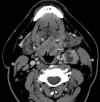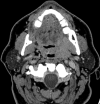Differences in imaging characteristics of HPV-positive and HPV-Negative oropharyngeal cancers: a blinded matched-pair analysis
- PMID: 23660291
- PMCID: PMC3951375
- DOI: 10.3174/ajnr.A3524
Differences in imaging characteristics of HPV-positive and HPV-Negative oropharyngeal cancers: a blinded matched-pair analysis
Abstract
Background and purpose: Human papillomavirus-positive oropharyngeal cancers typically have younger age of onset, limited tobacco exposure, and more favorable prognosis than HPV-negative oropharyngeal cancers. We assessed whether HPV-positive and HPV-negative oropharyngeal cancers have consistent differences in pretreatment imaging characteristics.
Materials and methods: A retrospective review of 136 pretreatment CT examinations of paired HPV-positive and HPV-negative oropharyngeal cancers matched for T stage, tumor subsite, and smoking status was performed with the reviewing radiologist blinded to HPV status and clinical stage. Demographic/clinical characteristics and imaging characteristics of primary lesions and metastatic nodal disease were compared by use of Fisher exact testing. The McNemar χ(2) test was used for the matched-pair analysis.
Results: By imaging, HPV-negative tumors were more likely to demonstrate invasion of adjacent muscle (26% versus 6%, P = .013). HPV-positive primary tumors were more likely to be enhancing and exophytic with well-defined borders, whereas HPV-negative primary tumors were more likely to be isoattenuated and demonstrate ill-defined borders, though these results were not statistically significant. HPV-positive tumors were more likely to demonstrate cystic nodal metastases than HPV-negative tumors (36% versus 9%, P = .002).
Conclusions: In this matched and blinded analysis of the imaging differences between HPV-positive and HPV-negative oropharyngeal cancers, HPV-positive carcinomas often had primary lesions with well-defined borders and cystic nodal metastases, whereas HPV-negative primaries more often had poorly defined borders and invasion of adjacent muscle.
Figures




Similar articles
-
Influence of smoking history on imaging characteristics among patients with human papillomavirus-positive oropharyngeal cancer: a blinded matched-pair analysis.J Comput Assist Tomogr. 2014 Sep-Oct;38(5):667-73. doi: 10.1097/RCT.0000000000000100. J Comput Assist Tomogr. 2014. PMID: 24943254 Free PMC article.
-
The association between T-stage and clinical nodal metastasis In HPV-positive oropharyngeal cancer.Am J Otolaryngol. 2014 Jul-Aug;35(4):463-8. doi: 10.1016/j.amjoto.2013.12.008. Epub 2013 Dec 21. Am J Otolaryngol. 2014. PMID: 24780201
-
Human papillomavirus-associated oropharyngeal squamous cell carcinomas: primary tumor burden and survival in surgical patients.Ann Otol Rhinol Laryngol. 2009 May;118(5):368-73. doi: 10.1177/000348940911800509. Ann Otol Rhinol Laryngol. 2009. PMID: 19548387
-
Advances in Diagnosis and Multidisciplinary Management of Oropharyngeal Squamous Cell Carcinoma: State of the Art.Radiographics. 2019 Nov-Dec;39(7):2055-2068. doi: 10.1148/rg.2019190007. Epub 2019 Oct 11. Radiographics. 2019. PMID: 31603733 Review.
-
The prevalence of human papilloma virus (HPV) infections in oral squamous cell carcinomas: a retrospective analysis of 88 patients and literature overview.J Craniomaxillofac Surg. 2014 Oct;42(7):1506-14. doi: 10.1016/j.jcms.2014.04.022. Epub 2014 May 10. J Craniomaxillofac Surg. 2014. PMID: 24947612 Review.
Cited by
-
Diagnostic performance of core needle biopsy for nodal recurrences in patients with head and neck squamous cell carcinoma.Sci Rep. 2022 Feb 7;12(1):2048. doi: 10.1038/s41598-022-06102-0. Sci Rep. 2022. PMID: 35132145 Free PMC article.
-
Morphologic diversity in human papillomavirus-related oropharyngeal squamous cell carcinoma: Catch Me If You Can!Mod Pathol. 2017 Jan;30(s1):S44-S53. doi: 10.1038/modpathol.2016.152. Mod Pathol. 2017. PMID: 28060372 Review.
-
MRI for Differentiation between HPV-Positive and HPV-Negative Oropharyngeal Squamous Cell Carcinoma: A Systematic Review.Cancers (Basel). 2024 May 31;16(11):2105. doi: 10.3390/cancers16112105. Cancers (Basel). 2024. PMID: 38893224 Free PMC article. Review.
-
Quantitative Diffusion-Weighted Imaging Analyses to Predict Response to Neoadjuvant Immunotherapy in Patients with Locally Advanced Head and Neck Carcinoma.Cancers (Basel). 2022 Dec 17;14(24):6235. doi: 10.3390/cancers14246235. Cancers (Basel). 2022. PMID: 36551718 Free PMC article.
-
Imaging of human papilloma virus (HPV) related oropharynx tumour: what we know to date.Infect Agent Cancer. 2023 Oct 9;18(1):58. doi: 10.1186/s13027-023-00530-x. Infect Agent Cancer. 2023. PMID: 37814320 Free PMC article. Review.
References
-
- Chaturvedi AK, Engels EA, Anderson WF, et al. . Incidence trends for human papillomavirus-related and -unrelated oral squamous cell carcinomas in the United States. J Clin Oncol 2008;26:612–19 - PubMed
-
- Carvalho AL, Nishimoto IN, Califano JA, et al. . Trends in incidence and prognosis for head and neck cancer in the United States: a site-specific analysis of the SEER database. Int J Cancer 2005;114:806–16 - PubMed
-
- Shiboski CH, Schmidt BL, Jordan RC. Tongue and tonsil carcinoma: increasing trends in the US population ages 20–44 years. Cancer 2005;103:1843–49 - PubMed
-
- Sturgis EM, Ang KK. The epidemic of HPV-associated oropharyngeal cancer is here: is it time to change our treatment paradigms? J Natl Compr Canc Netw 2011;9:665–73 - PubMed
-
- Sturgis EM, Cinciripini PM. Trends in head and neck cancer incidence in relation to smoking prevalence: an emerging epidemic of human papillomavirus-associated cancers? Cancer 2007;110:1429–35 - PubMed
Publication types
MeSH terms
Grants and funding
LinkOut - more resources
Full Text Sources
Other Literature Sources
Medical
